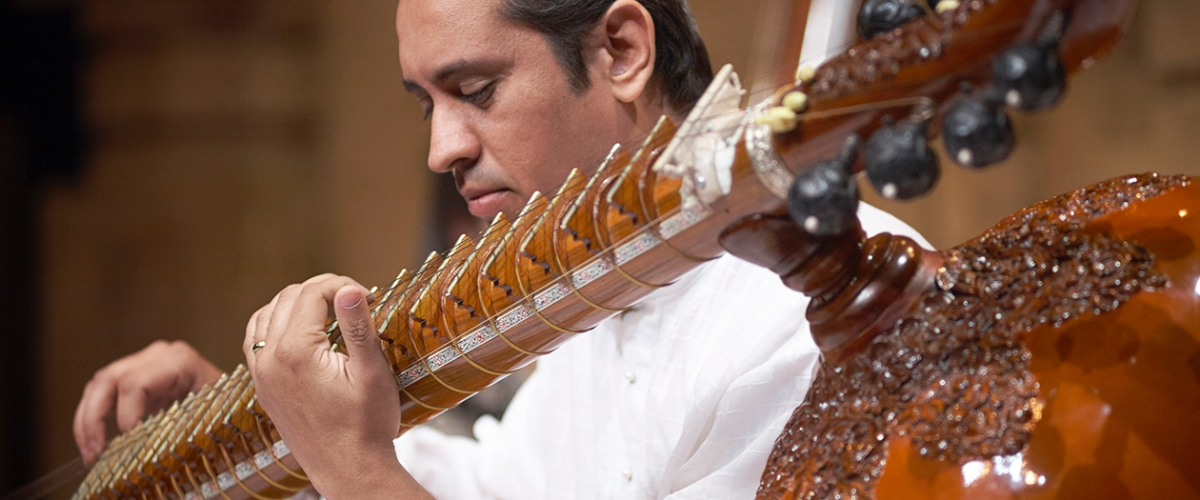

The veena, also known as the been in North Indian languages, is a large plucked lute. It is undoubtedly one of India’s oldest instruments, dating from around the 1st millennium BC - not only do many references appear in ancient Vedic scriptures but there are also temple sculptures of that period clearly showing veena-like lutes. Musicians often consider it the mother of all string instruments, as it has the largest range of octaves and demands from its exponents a very great, in-depth knowledge of all aspects of Indian classical music.
There are two main strands of the veena – one evolving from earlier, simpler lutes and the other is thought to have descended from the struck-stringed family of zither-style instruments. Although rarely-heard nowadays, the been was the main string instrument during the later period of Mughal rule in India (from 1700 onwards), and was used as the chief accompaniment for Dhrupad (the oldest classical vocal) music. Hence, veena players in the North Indian classical music tradition are usually associated with families who practice Dhrupad.
Inevitably, as the more modern vocal genre, khayal, began to come into vogue and Dhrupad began to decline in the 19th century, the fortunes of the veena declined alongside it. But the early 20th century saw something of a revival in that the veena emerged as a solo instrument and the only one thought to be capable of playing in the Dhrupad style, to which it had been so closely associated in the past. There are still very few North Indian musicians who play this instrument and good quality recordings are equally rare.
There are other variations of the same ancient veena used for Carnatic music in South India, but the two main kinds played in North Indian music are known as rudra veena ('roaring veena') and the even rarer vichitra veena ('curious veena'). The three main differences between the two types are:
• Unlike the rudra veena, the vichitra veena is fretless.
• The vichitra veena is placed on the floor, in front of the player whilst the rudra veena is played by being placed across the lap with one gourd over the shoulder, similar to the playing position for the sitar.
• The vichitra veena is played with a slide, usually a small glass ball which is moved with one hand across the main melody strings while two plectrums are worn on the middle and index fingers.
Other than that, both kinds of veena are similar in structure, with a stem of about three feet, and identical-sized gourds placed at both ends for resonance. The fingerboard is hollow to allow the sympathetic strings to pass through and is divided in two parts, with the upper part featuring some kind of ornamental animal head just above the large tuning pegs for the main strings and the other part holds the pegs for the drone and sympathetic strings.
The 20th century’s most outstanding exponent of rudra veena, the late Ustad Zia Mohiuddin Dagar, whose family established the Dagarvani Dhrupad style, made considerable modifications to the instrument including larger gourds, a thicker stem, and thicker metal strings. He also played with the fingers rather than a plecturm, all of which contributed to a softer yet more deeply resonant sound.
Listen to the music | Ustad Bahauddin Dagar’s, Zia Mohiuddin's son, is the rudra veena's leading modern exponent - here he uses the instrument's fluid bends and long, low tones to elablorate Raag Patdeep at Darbar Festival 2013. (Also listen to Pandit Gopal Shankar Mishra playing Raag Darbari Kanada on the vichitra veena).
Jameela Siddiqi is an author, linguist, and BBC cultural commentator, specialising in postcolonial fiction and the devotional music of South Asia.
Darbar believes in the power of Indian classical music to stir, thrill, and inspire. Explore our YouTube channel, or subscribe to the Darbar Concert Hall to watch extended festival performances, talk and documentaries in pristine HD and UHD quality.
There are two kinds of Indian classical music, Hindustani (North Indian) and Carnatic (South Indian), descended from...
Read More 
VR360 Festival | Darbar brings Indian classical music into the realm of virtual reality. We see VR as a way of...
Read More 
The violin is one of the most important instruments in Western classical music, owing not only to a unique strength...
Read More 
The beginner's guide to Indian classical music. Whether you’re completely new to raga music or just need a refresher, we’ve put together this brief overview of all things raga music to help you feel at ease when visiting one of our concerts or watch our videos on our YouTube or our Darbar Concert Hall.
Keep up to date with the latest news, events, music and musings across our social channels
For hundreds more clips and shorts, vist our YT page here 